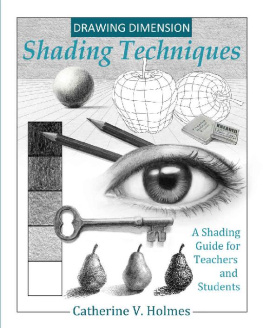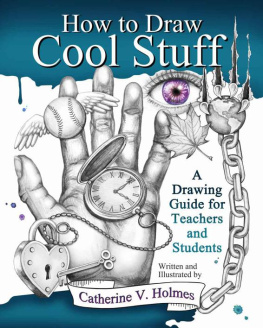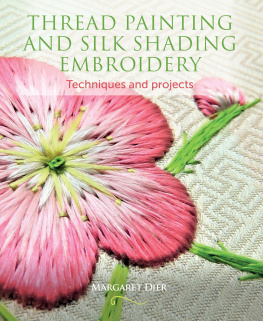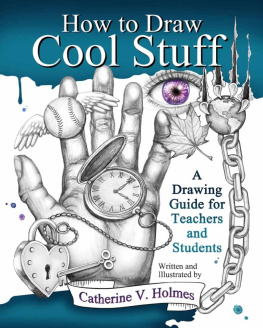Catherine V Holmes - Drawing Dimension Shading Techniques A Shading Guide for Teachers and Students
Here you can read online Catherine V Holmes - Drawing Dimension Shading Techniques A Shading Guide for Teachers and Students full text of the book (entire story) in english for free. Download pdf and epub, get meaning, cover and reviews about this ebook. year: 0, genre: Art / Computer. Description of the work, (preface) as well as reviews are available. Best literature library LitArk.com created for fans of good reading and offers a wide selection of genres:
Romance novel
Science fiction
Adventure
Detective
Science
History
Home and family
Prose
Art
Politics
Computer
Non-fiction
Religion
Business
Children
Humor
Choose a favorite category and find really read worthwhile books. Enjoy immersion in the world of imagination, feel the emotions of the characters or learn something new for yourself, make an fascinating discovery.
- Book:Drawing Dimension Shading Techniques A Shading Guide for Teachers and Students
- Author:
- Genre:
- Year:0
- Rating:3 / 5
- Favourites:Add to favourites
- Your mark:
- 60
- 1
- 2
- 3
- 4
- 5
Drawing Dimension Shading Techniques A Shading Guide for Teachers and Students: summary, description and annotation
We offer to read an annotation, description, summary or preface (depends on what the author of the book "Drawing Dimension Shading Techniques A Shading Guide for Teachers and Students" wrote himself). If you haven't found the necessary information about the book — write in the comments, we will try to find it.
Drawing Dimension Shading Techniques A Shading Guide for Teachers and Students — read online for free the complete book (whole text) full work
Below is the text of the book, divided by pages. System saving the place of the last page read, allows you to conveniently read the book "Drawing Dimension Shading Techniques A Shading Guide for Teachers and Students" online for free, without having to search again every time where you left off. Put a bookmark, and you can go to the page where you finished reading at any time.
Font size:
Interval:
Bookmark:

Published by:
Library Tales Publishing
www.LibraryTalesPublishing.com
www.Facebook.com/LibraryTalesPublishing
Copyright 2017 by Catherine V. Holmes
Published by Library Tales Publishing, Inc., New York, New York
No part of this publication may be reproduced, stored in a retrieval system, or transmitted in any form or by any means, electronic, mechanical, photocopying, recording, scanning, or otherwise, except as permitted under Sections 107 or 108 of the 1976 United States Copyright Act, without the prior written permission of the Publisher.
Requests to the Publisher for permission should be addressed to the Legal Department, Library Tales Publishing, P.O Box 20407, New York, NY, 10023. 1-800-754-5016; Legal@LibraryTales.com
ISBN-13:978-0692919842
ISBN-10: 0692919848
Library of Congress Control Number: 2017948516
SHADING TECHNIQUES
A Shading Guide for Teachers and Students

ACKNOWLEDGEMENTS
Dedicated to Charlotte and Taya, the sources
that inspire me to be creative everyday.
Thank you to Virginia Holmes Thayer, David Thayer, Kenneth Holmes, Kathleen Holmes, Jeff Costello, Marcia Pennington and Jay Costello for your continued love and support. Thank you to Craftsy for giving me the opportunity to teach through a new platform, Usher Morgan and
Library Tales, Carrie King, Leonardos Library, Annie, Kat, Dan and the crew from the Holbrook Public Library, the folks at Dennett Elementary, my fellow CES teachers, Norman Small, Carol Johnson, and my students for inspiring me.
Other Titles in the How to Draw Cool Stuff Series

How to Draw Cool Stuff: A Drawing Guide for Teachers and Students
This book shows simple step-by-step illustrations that make it easy for anyone to draw cool stuff with precision and confidence. These lessons will help you see line, shape, space and other elements in everyday objects and turn them into detailed works of art in just a few simple steps. The exercises in this book will help train your brain so you can visualize ordinary objects in a different manner, allowing you to see through the eyes of an artist. From photorealistic faces to holiday themes and tattoo drawings, How to Draw Cool Stuff makes drawing easier than you would think and more fun than you ever imagined!

How to Draw Cool Stuff: Basics, Shading, Texture, Pattern and Optical Illusions is the second book in the How to Draw Cool Stuff series. Inside you will find simple illustrations that cover the necessities of drawing cool stuff. Specific exercises are provided that offer step-by-step guidelines for drawing a variety of subjects. Each lesson starts with an easy-to-draw shape that will become the basic structure of the drawing. From there, each step adds elements to that structure, allowing the artist to build on their creation and make a more detailed image. Starting with the basic forms, the artist is provided a guide to help see objects in terms of simplified shapes. Instructions for shading to add depth, contrast, character and movement to a drawing are then covered.

How to Draw Cool Stuff: Holidays, Seasons and Events is a step-by-step drawing guide that illustrates popular celebrations, holidays and events for your drawing pleasure. From the Chinese New Year to April Fools Day, Fathers Day to Halloween, Christmas and New Year s Eve - this book covers over 100 fun days, holidays, seasons and events, and offers simple lessons that will teach you how to draw like a pro and get you in the spirit of whichever season it may be! The third book in the How To Draw Cool Stuff series, this exciting new title will teach you how to create simple illustrations using basic shapes and a drawing technique that simplifies the process of drawing, all while helping you construct height, width and depth in your work.
TABLE OF CONTENTS
: Introduction to Tools
: Putting the Tools To Use
: Five-Toned Drawing Exercise
: Cross-Contour Drawing
: Shading With Cross-Contour Lines
: Light Source and Shadow
: Shading a Tree Realistically
: Gradations, Highlights, Reflections, and Blending
: Shading With Pen
: Contrast and Focal Point
: Combining Techniques
INTRODUCTION
Welcome to Drawing Dimension: Shading Techniques . Shading is one of the easiest ways to add depth, contrast, character, and movement to your drawings. By shading and adding tone properly, an artist can greatly improve the quality of his or her drawings. This is a skill that can be learned and it is not a difficult skill to grasp, but it does take some practice. By controlling pencil pressure and stroke, understanding light, and having knowledge of blending techniques, an artist can enhance their work and offer the wow factor needed in order to make an artwork convincingly realistic.
Shading captures the variation in value within an image and describes the form of an object. The inclusion of highlights and shadows in an artwork takes a two-dimensional image that has width and height and adds depth, giving an artwork the appearance of having three-dimensional qualities. This revolves mainly around identifying light sources and replicating them to create shape and volume using contrast as opposed to just lines.
This book, based on my online Craftsy drawing class, Drawing Dimension: Shading Techniques , offers a series of shading tutorials that are easy to understand and apply, exploring ideas beyond simple step-by-step instruction. The reader is offered direction as well as a deeper look in to the learning process by nurturing technique and understanding. Along with instruction, there are three principles to each lesson: Know, Understand and Do. To truly grasp a concept in art, an artist needs to know about the techniques they are using, as well as understand how theyre used and what they communicate in order to be able to use them effectively. Knowing is to simply recognize the facts and basic vocabulary of an idea. To understand is to comprehend the core meaning and principles of that idea, enabling the artist to make important generalizations and use insight when creating or discussing a work. Understanding requires higher-order thinking and does not have just one answer. Doing is to create and demonstrate the skills learned. This can be a final product (artwork) but can also include analyzing, compare/contrast, creative problem solving, and speculating. Understanding and doing promotes thinking and independent learning. To just know an idea is often simply the recall of information or facts. There is often one right answer. It is through the understanding component where an artist truly grasps the relevance of a lesson or experience. Understanding can be transferred from one situation to another, applied to new situations and other projects, not just one lesson being taught. Understanding is not something that can be memorized. This book aims to help an artist understand.
Font size:
Interval:
Bookmark:
Similar books «Drawing Dimension Shading Techniques A Shading Guide for Teachers and Students»
Look at similar books to Drawing Dimension Shading Techniques A Shading Guide for Teachers and Students. We have selected literature similar in name and meaning in the hope of providing readers with more options to find new, interesting, not yet read works.
Discussion, reviews of the book Drawing Dimension Shading Techniques A Shading Guide for Teachers and Students and just readers' own opinions. Leave your comments, write what you think about the work, its meaning or the main characters. Specify what exactly you liked and what you didn't like, and why you think so.








